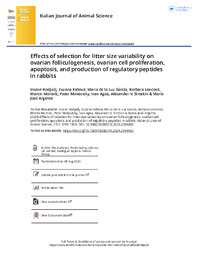Título :
Effects of selection for litter size variability on
ovarian folliculogenesis, ovarian cell proliferation,
apoptosis, and production of regulatory peptides
in rabbits |
Autor :
Hadjadj, Imane
Fabová, Zuzana
García, Maria de la Luz
Loncová, Barbora
Morovic, Martin
Makovicky, Peter
Agea, Iván 
Sirotkin, Alexander V.
Argente, Maria Jose |
Editor :
Taylor & Francis Group |
Departamento:
Departamentos de la UMH::Tecnología Agroalimentaria |
Fecha de publicación:
2024 |
URI :
https://hdl.handle.net/11000/33937 |
Resumen :
The present study aimed to identify the novel mechanisms regulating rabbit fecundity. For this
purpose, the association between litter size variability, fecundity, ovarian morphology, and
markers of proliferation, apoptosis, steroidogenesis, and the presence of regulatory proteins
were examined in ovarian cells from two rabbit lines divergently selected for low (LL) and high
(HL) variability in litter size throughout sixteen generations. Ovaries and uteri were isolated from
multiparous non-lactating female rabbits from each line at sixteen generations of selection. One
part of the ovary was subjected to histomorphometric analysis of folliculogenesis. From the rest
of ovary, ovarian granulosa cells (OGCs) were isolated, cultured, and cell viability, proliferation
(accumulation of PCNA and of cyclin B1, and BrdU-positive cells), and apoptosis (accumulation
of caspase 3, bax and DNA fragmentation) were evaluated by the Trypan blue exclusion test
and BrdU, quantitative immunocytochemistry, and cell death detection assays. Furthermore,
OGCs were subjected to proteomic analysis by using the nano HPLC-Chip-MS/MS method. The
release of progesterone and oestradiol was measured by ELISA. The LL had more than one kit
per litter than the HL (7.6 kits vs. 6.5 kits, p � 0.05). No differences were found in the diameter
of primordial and primary ovarian follicles, theca, and granulosa thickness, but the diameter of
oocytes in the primary and secondary follicles was higher in the LL than in the HL (88.49 mm in
the LL vs. 77.86 mm in the HL for oocytes of primary follicles, p � 0.05; 122.10 mm in the LL vs.
109.87 mm in the HL for oocytes of secondary follicles, p � 0.05). Preovulatory follicles were pre-
sented only in the ovaries of the LL. The LL had higher incorporation of BrdU and reduced accu-
mulation of bax within OGCs (0.92% in the LL vs. 0.44% in the HL for incorporation of BrdU,
p � 0.05; 41% in the LL vs. 48% in the HL for accumulation of bax, p � 0.05). Ovarian fragments
from the LL produced less progesterone and oestradiol than those of the HL (12 ng/mg tissue/
day in the LL vs, 45 ng/mg tissue/day in the HL for progesterone, p � 0.05; 11 ng/mg tissue/day
in the LL vs. 30 ng/mg tissue/day in the HL for oestradiol, p � 0.05). Besides, the OGCs from the
LL produced a higher number of specific regulatory proteins involved in cell differentiation, pro-
liferation, and adhesion than the HL (50 vs 38, p � 0.05). In conclusion, higher prolificacy in the
LL line would be caused by: (1) the selection of growing primordial ovarian follicles; (2) better
transformation to preovulatory follicles; (3) increased cytoplasmic maturation of oocytes; (4)
increased DNA synthesis and decreased cytoplasmic apoptosis in OGCs; (5) changes in ovarian
steroidogenesis; and (6) changes in the number of peptides involved in cell differentiation, pro-
liferation, and adhesion.
|
Palabras clave/Materias:
Ovary
hormones
apoptosis
proliferation
cell cycle |
Área de conocimiento :
CDU: Ciencias aplicadas: Ingeniería. Tecnología |
Tipo de documento :
info:eu-repo/semantics/article |
Derechos de acceso:
info:eu-repo/semantics/openAccess
Attribution-NonCommercial-NoDerivatives 4.0 Internacional |
DOI :
https://doi.org/10.1080/1828051X.2024.2396482 |
Publicado en:
ITALIAN JOURNAL OF ANIMAL SCIENCE 2024, VOL. 23, NO. 1, 1290–1304 |
Aparece en las colecciones:
Artículos Tecnología Agroalimentaria
|

 La licencia se describe como: Atribución-NonComercial-NoDerivada 4.0 Internacional.
La licencia se describe como: Atribución-NonComercial-NoDerivada 4.0 Internacional.
.png)